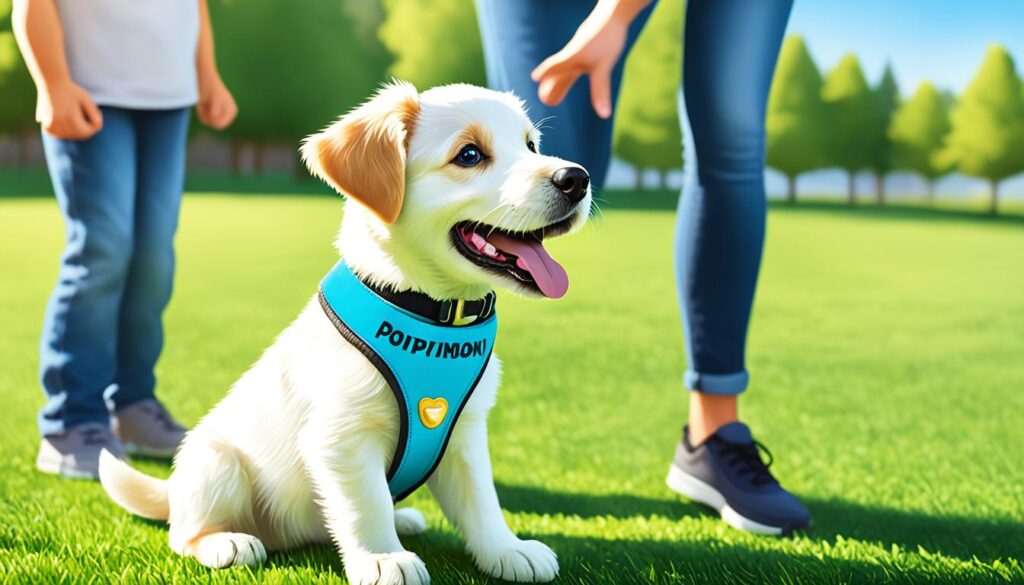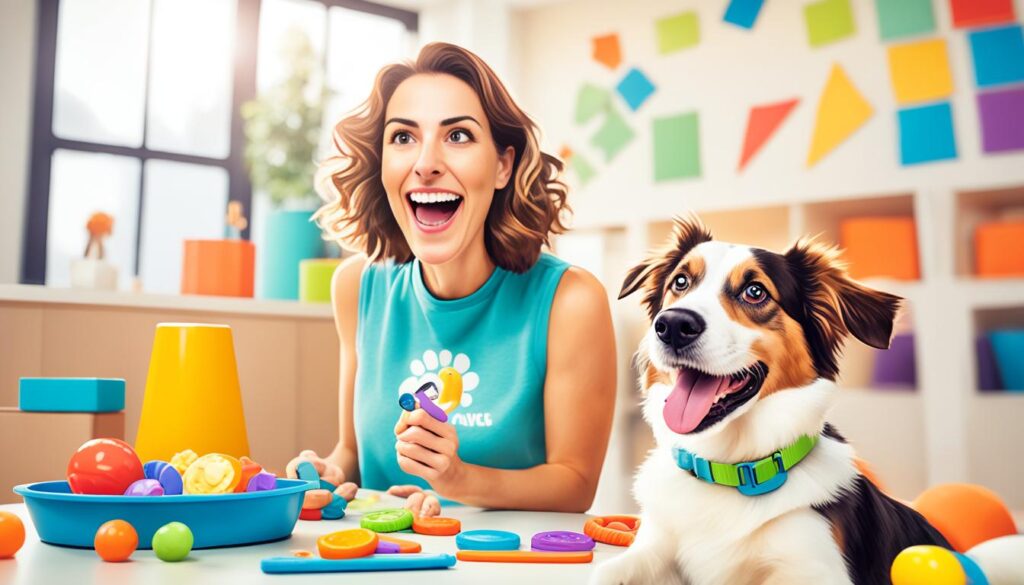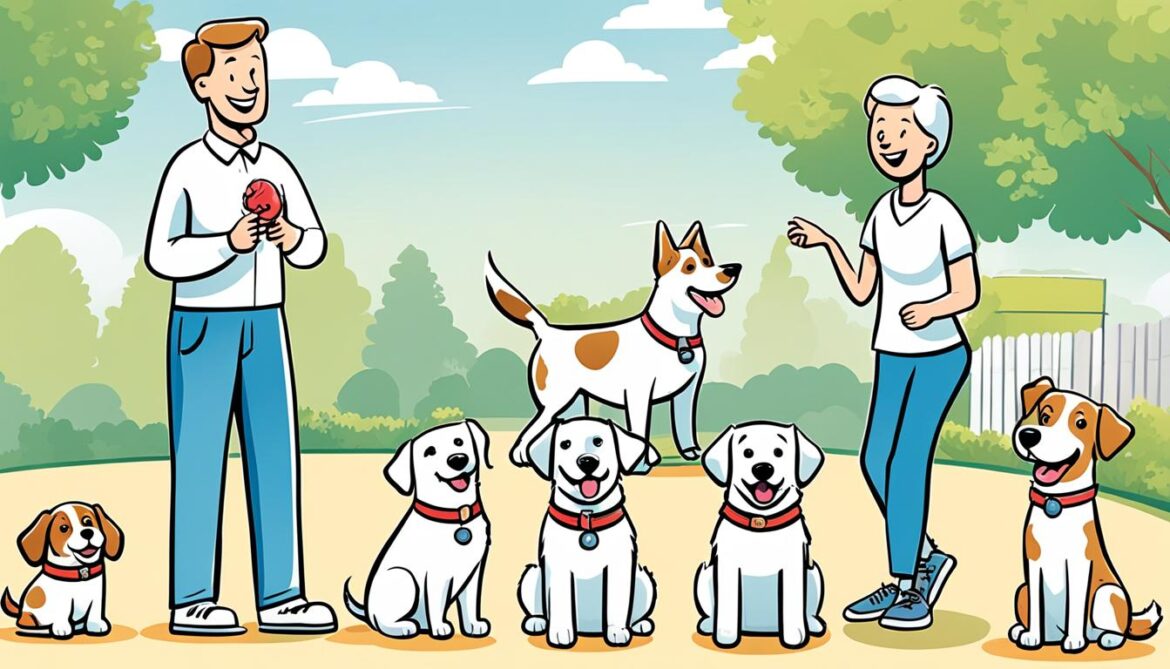Imagine coming home to a loyal companion who greets you with a wagging tail and eyes filled with love. A well-trained dog can truly bring joy and happiness into our lives. Whether you’re a first-time dog owner or have had furry friends in the past, training a dog is a journey worth embarking on. It’s an opportunity to build a strong bond with your pet, foster good behavior, and create a harmonious living environment.
But we understand that training a dog can feel overwhelming at times. You might be faced with challenges, such as managing unwanted behaviors, teaching basic commands, or even leash training. That’s why we’re here to help you navigate through the ups and downs of dog training.
In this article, we will provide you with invaluable tips and techniques to guide you in successfully training your dog. From puppy training to positive reinforcement, we’ll cover it all so you can enjoy a well-behaved, happy, and fulfilled furry companion by your side.
Key Takeaways:
- Training your dog is an opportunity to build a strong bond and create a harmonious living environment.
- Training a dog can feel overwhelming, but with the right techniques, it can be a rewarding journey.
- In this article, we will provide invaluable tips and techniques for successful dog training.
- Topics covered include puppy training, positive reinforcement, and mastering leash training.
- By following these tips, you can have a well-behaved and happy furry companion.
Puppy Training Techniques for a Well-Behaved Dog
Welcome to the second section of our dog training guide! In this section, we will focus on puppy training techniques specifically designed to help you raise a well-behaved and obedient dog. By establishing good behavior habits from an early age, you can ensure a harmonious relationship and a happy, well-adjusted pooch.

One of the first and most important aspects of puppy training is crate training. Introducing your puppy to a crate not only provides them with a safe and secure space but also helps with potty training and preventing destructive behavior. Gradually acclimate your puppy to the crate by making it a positive and rewarding experience.
Another crucial aspect of puppy training is potty training. Establishing a consistent routine and using positive reinforcement will help your puppy learn where and when to go potty. Remember to praise and reward your puppy for successfully eliminating in the designated area.
Basic commands are an essential part of puppy training. Teaching your puppy commands like sit, stay, and come will not only ensure their safety but also enhance communication between you and your furry friend. Training sessions should be short, fun, and positive to keep your puppy engaged and eager to learn.
A well-trained dog is a happy dog, and it all starts with effective puppy training techniques!
To summarize, here are some key puppy training techniques for a well-behaved dog:
| Technique | Description |
|---|---|
| Crate training | Introduce your puppy to a crate as a safe and secure space. |
| Potty training | Establish a consistent routine and use positive reinforcement to teach your puppy where and when to go potty. |
| Basic commands | Teach your puppy essential commands like sit, stay, and come for better communication and obedience. |
Remember, patience, consistency, and positive reinforcement are key when training your puppy. Stay tuned for our next section, where we will explore the power of positive reinforcement training in more detail.
Positive Reinforcement Training: The Key to a Happy Pet
Discover the power of positive reinforcement training and unlock a harmonious relationship with your beloved pet. Positive reinforcement is a proven and effective technique that focuses on rewarding desired behaviors instead of punishing unwanted ones. This method not only cultivates a happy and well-behaved pet but also strengthens the bond between you and your furry friend.
With positive reinforcement training, you can transform your pet’s behavior by accentuating their positive actions. By offering rewards such as treats, praise, or playtime, you encourage your pet to repeat these behaviors. This creates a positive association in their minds, making training a fun and enjoyable experience for both of you.
One of the key benefits of positive reinforcement training is its effectiveness in addressing unwanted behaviors. Instead of using punishment or correction, this approach focuses on redirecting your pet’s attention to appropriate behaviors and rewarding them when they make the right choices. This helps to eliminate problem behaviors naturally and promotes a safe and nurturing environment at home.
To incorporate positive reinforcement training into your pet’s routine, follow these simple steps:
- Identify the desired behavior you want to reinforce. Whether it’s sitting, walking politely on a leash, or coming when called, choose one behavior at a time to focus on.
- Use a clicker or a verbal marker, such as “Yes!” or “Good boy/girl!” to mark the moment your pet exhibits the desired behavior.
- Immediately reward your pet with a treat, praise, or a pat on the head. Make sure the reward is something your pet finds highly motivating.
- Repeat these steps consistently, gradually reducing the frequency of rewards as your pet becomes more proficient in the desired behavior.
Remember, consistency and patience are key when using positive reinforcement training. It may take time for your pet to understand and respond to the training, but with dedication and repetition, you will see remarkable progress. Celebrate your pet’s successes along the way and always provide a calm and supportive environment for learning.
By embracing positive reinforcement training, you create a nurturing and empowering environment for your pet, setting them up for a lifetime of happiness and obedience. Say goodbye to outdated training methods and unlock the transformative power of positive reinforcement. Start training your pet today and witness the incredible results that come from a compassionate and rewarding approach.

“Train your pets with love and rewards, and watch them flourish.”
Mastering Leash Training: Walks Made Easy
Leash training is an essential skill for any dog owner. Not only does it ensure your pet’s safety during outdoor activities, but it also promotes good behavior and obedience. In this section, we will guide you through step-by-step techniques to teach your dog to walk calmly on a leash and respond to commands.
To begin leash training, it’s important to have the right equipment. Choose a sturdy leash that is appropriate for your dog’s size and strength. A standard leash length of 4 to 6 feet is ideal for control and comfort.
Before you start walking, introduce your dog to the leash in a positive and relaxed environment. Allow your pet to sniff and investigate the leash, associating it with positive experiences such as treats or playtime.
Step 1: Loose Leash Walking
The first step in leash training is teaching your dog to walk without pulling. Start by holding the leash in your hand with a relaxed grip. Encourage your dog to walk beside you using treats or verbal cues like “heel” or “walk.”
- When your dog starts pulling or moving ahead, stop walking.
- Stand still and wait for your dog to release tension on the leash.
- Once your dog returns to your side, reward them with praise and a treat.
- Continue walking, repeating this process whenever your dog pulls.
This method reinforces the concept that loose leash walking is rewarding and pulling is not. With consistency and patience, your dog will learn to walk calmly on a loose leash.
Step 2: Addressing Pulling and Distractions
Many dogs tend to pull on the leash, especially when they encounter distractions or exciting stimuli. It’s important to address this behavior to ensure a pleasant walking experience for both you and your pet.
“Pulling on the leash is a common behavior, but it can be corrected with training and consistency.”
Here are some tips to help you tackle pulling and distractions during walks:
- Teach your dog a reliable “leave it” command to redirect their attention from distractions.
- Use positive reinforcement techniques such as treats and praise for walking calmly past distractions.
- Practice walking in less stimulating environments before gradually increasing the level of distractions.
- Consider using a front-clip harness or head halter to discourage pulling.
Step 3: Managing Leash Aggression
Leash aggression is a common challenge that many dog owners face. It can manifest as growling, lunging, or barking at other dogs or animals while on a leash. Addressing leash aggression requires patience and careful training techniques.
“Understanding the root cause of leash aggression is crucial in developing an effective training plan.”
If your dog displays leash aggression, here are some strategies to help manage and improve their behavior:
- Consult with a professional dog trainer or animal behaviorist for guidance and specialized training.
- Practice obedience training exercises to increase your dog’s focus and impulse control.
- Use counterconditioning techniques to create positive associations with other dogs or animals.
- Gradually expose your dog to controlled social situations, ensuring their safety and comfort.
Conclusion
In conclusion, training your dog is a rewarding journey that requires patience, consistency, and positive reinforcement. By implementing clicker training, a highly effective tool, you can reinforce the desired behaviors in your furry companion.
Clicker training for dogs is based on the principle of positive reinforcement, where the sound of a clicker is paired with a reward. This method helps your dog associate the desirable behavior with the click and eventually the reward, making it easier for them to understand and repeat the behavior.
With the right techniques and a loving approach, you can have a well-trained and happy canine companion. Remember to be consistent, provide regular training sessions, and use positive reinforcement as the foundation of your training program. Celebrate each small achievement and enjoy the journey of building a strong bond with your furry friend through effective clicker training.
